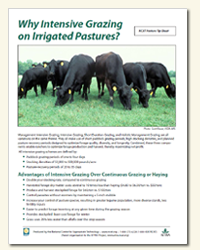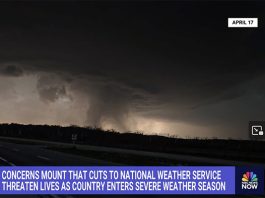
Out West, you either do or you don’t – have irrigation that is. And it’s an important question because even though the principles are similar whether you’re grazing irrigated pastures or rainfall pastures, there are some important differences.
For one, assuming that your water holds up, irrigated pastures typically have a fairly constant yield over the course of the grazing season. Western skies are often fair and heat units abound. Irrigation systems allow you to correctly supply the water to your crop.
The forage yields you get from your pasture tend to be predictable and stable as long as you can keep your inputs steady. Because irrigation helps you maintain these inputs, the relatively constant supply of forage that irrigated pastures produce make them perfect for intensive grazing.
What is Intensive Grazing?
Intensive grazing is generally characterized by stocking densities – 50,000 to 150,000 animal pounds per acre. Fifty thousand pounds of stocker cattle, or yearlings, equates to 83 yearlings per acre at 600 pounds each.
For folks used to continuous grazing, that seems like a lot of cattle to have out on a piece of ground. Each of these 6-weight yearlings will eat 3 percent of their body weight, or 18 pounds, of forage dry matter per day. If you turn 83 of them out on one acre and intend to be gone for 24 hours, you had better be sure that there are 1,900 plus pounds of forage dry matter out there. That is, if you don’t want to be chasing cows in true Western fashion!
Paddock Grazing Periods and Pasture Recovery Time
Timing is critical for intensive systems – you’ll be grazing livestock in paddocks for periods of one to four days and allowing pasture to recover for periods of 20 to 35 days. The length of time that you choose for these two time parameters will greatly influence your pasture’s labor demands, plant diversity, added fertility inputs, parasite control, and longevity. Since paddock- grazing and pasture-recovery periods are such key components of your intensive grazing design, we’ll look at them in detail in an upcoming series of articles.
But before we go any further here, it’s a good idea to note that increasing stocking densities beyond 200,000 pounds per acre is getting into the realm of so-called mob – or ultra-high stock density – grazing. Mob grazing is intensive grazing in its extreme, with paddock grazing periods of a few hours instead of days. It also employs pasture rest periods of two to four times those used on intensively grazed irrigated pastures. Mob grazing is a practice in and of itself and requires additional grazing skill.
The Advantages

By now you may be thinking that this intensive grazing sounds like work and there had better be some real advantage to this scheme. There is: a much improved bottom line.
The first and most obvious advantage intensive grazing enjoys over continuous grazing is the doubling of your pastures’ carrying capacity. Instantly, your land costs are cut in half! Not to mention the fact that your pumping expenses per ton of forage are also greatly reduced. And if you’re looking for even more reasons to jump off the haying merry-go-round and let the cows do more of the harvesting, remember that it costs several to 10 times less to harvest a ton of forage through intensive grazing than it does through haying. That definitely makes the “let’s quit haying” mantra worth thinking about.
Trick of the Trade
The whole trick to quitting haying is stockpiling pasture (letting it grow and saving it on the stump) for fall and winter use and adjusting your calving or lambing time to take advantage of what this stockpile has to offer. Currently, western feeder hay is selling for $150 to $200 per ton. Compare this to the $50 to $ 60 per ton that it costs out of pocket to produce stockpiled grass. Wherever you are, perhaps you should think twice about feeding hay to livestock that are giving birth three to four months out from grass. For every ton of hay you feed, you are losing upwards of $150. Run that by your banker and watch him sputter and cringe! With today’s prices of $120,000 for a swather and another $110,000 for a big square baler, you had better be putting up at least 3,000 tons of hay per year just to break even. And then there is the sad fact that you can’t pick up the bales by hand anymore! Add another $40,000 to your haying investment. Considering all this, four-footed feed harvesters look very appealing. Move your calving or lambing date up a few months and stockpile. You are in business.
Any Downsides?
So what is the catch? There are a few. Intensive grazing on irrigated pastures requires somewhat more planning and management than other grazing systems or haying. Are you willing to devote a little more time each day to coordinate irrigation with livestock movements? You will also need to keep a close tab on your pasture recovery period each time you move from field to field. At all costs, maintain the rest period you design into your grazing system. This may necessitate setting aside “out pastures” or feeding supplemental hay. (We graziers can use hay to our advantage!)
Think About It
 For more information on the advantages and considerations of intensive grazing, take a look at the tip sheet titled “Why Intensive Grazing on Irrigated Pastures?” on the National Center for Appropriate Technology’ s (NCAT) ATTRA website. And stay tuned for future articles about exactly how to set up an intensive grazing system that works.
For more information on the advantages and considerations of intensive grazing, take a look at the tip sheet titled “Why Intensive Grazing on Irrigated Pastures?” on the National Center for Appropriate Technology’ s (NCAT) ATTRA website. And stay tuned for future articles about exactly how to set up an intensive grazing system that works.
For now, give it some thought. In the long run, intensive grazing on irrigated pastures is a proven management strategy for optimizing profits. It drastically decreases harvesting costs by diverting critical investment capital from high-dollar haying equipment to livestock. Over time, livestock multiply and appreciate in value. Machinery does not reproduce, it only breaks down. The cost is your management time and labor. Are you allocating it to its best advantage?
Here Are The Rest of the Articles in This Series
Setting Up an Intensive Grazing System That Works – Pasture Rest Periods
Paddock Grazing Periods in Irrigated Pastures
Putting It All Together – Or Calling the Dance





Thanks Dave. Nice article. I’ll look forward to future articles as well. Way to represent Montana!
Comments are closed.